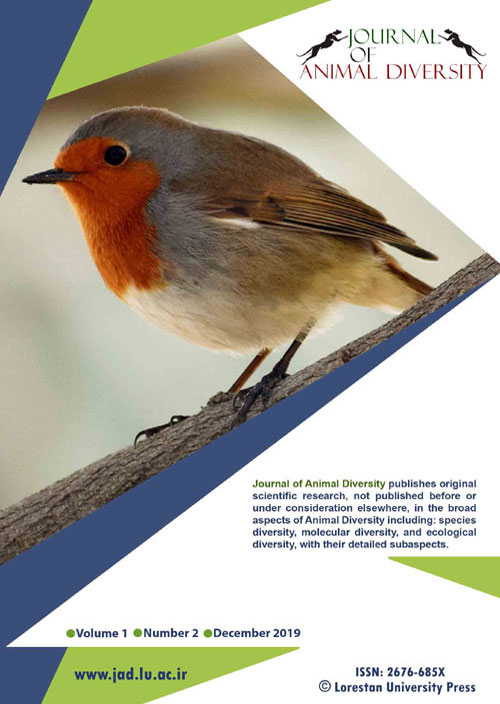فهرست مطالب

Journal of Animal Diversity
Volume:2 Issue: 3, Sep 2020
- تاریخ انتشار: 1399/10/02
- تعداد عناوین: 7
-
Pages 1-4
It is a truism that mammalian systematics is a dynamic field of research and that new species are still being discovered. The rate of change, however, is truly spectacular and the number of mammal species, estimated at 5,416 in 2005 (Wilson and Reeder, 2005) reached 6,495 just 13 years later (Burgin et al., 2018), i.e. an astonishing rise of 20%. Behind this progress is the wide application of new research tools, above all, highly effective DNA-based methods capable of reconstructing evolutionary pathways and delimiting morphologically cryptic species. Faunal revisions are as badly needed in this time of taxonomic revolution as ever before. They are of particular value when done by experts active in the fields of taxonomy research and species delimitation. It was therefore a pleasant surprise to receive a new publication of this kind which focuses on the rodents of Taiwan ...
Keywords: Mammals, Rodentia, species, endemic, Taiwan -
Pages 5-10
In the present study, we report the discovery of the poorly known striped ichthyophiid caecilian Ichthyophis longicephalus from three new localities, each in three southern Indian states; Karnataka, Kerala and Tamil Nadu. Present records and available information on this species enable us to revise its IUCN Red List conservation status from Data Deficient (DD) to Least Concern (LC).
Keywords: Anthropogenic influence, coffee, tea plantations, Kodagu, new site record, Peninsular India, range extension -
Pages 11-15
We re-address the findings of recent publications on herpetofaunal diversity of certain urban areas of Gujarat, India, in which, authors have claimed to report nine frogs and two lizard species for the first time from the State, without any morphological data and/or voucher specimens. We present our critique and comments, with the known distributional ranges of these species and on these erroneous records. We also advocate removal of such species from the faunal list of Gujarat until confirmed reports, based on correctly identified vouchers, are presented. We recommend here that identification of a species should be done following standard protocols and by facilitating the deposition of voucher specimen/s in responsible public repositories for studies involving taxonomy, morphology and range extension.
Keywords: Amphibians, Anura, reptiles, species distribution, species identification, Squamata, taxonomy -
Pages 16-23
Zaprionus indianus is a very successful invasive species with a high dispersion capacity. In this paper we present the first host record of the African fig fly pest for western Iran. We use molecular data to support the identification of this species. In total, 250 larval specimens were collected. After immature rearing and adult emergence under laboratory conditions, the specimens were identified as Z. indianus based on morphological characters. Then, the morphological identification was confirmed by BLAST analysis of the COI nucleotide sequence, which showed 97%–100% identity to COI sequences of Z. indianus, submitted from different parts of world. This study can provide some insights into the identification, ecology and host preference of Z. indianus as a new invasive and potentially major pomegranate pest in western Iran.
Keywords: Punica granatum, Drosophilidae, DNA barcoding, Phylogenetic tree, Lorestan, Western Iran -
Pages 24-36
Human-wildlife conflict (HWC) is on an increasing trend and has become one of the most challenging problems for the rural communities of developing nations like Nepal. There is limited information available on HWC in Kailali district, Nepal. The objective of our study was to explore the different incidents and the perceptions of local people on HWC within four different sites in Kailali district. To collect information three different methods were used, a questionnaire survey (n= 80), key informant interviews (n= 10) and focus group discussions (n= 4); all during February and March 2018. Different records of HWC incidents were collected that occurred during the period of one year in 2017, except for information on human attacks which were collected from 2015 to 2017. Of the total of 102 HWC incidents, crop damage was the most severe problem followed by property damage (15) and livestock depredation (9). The Asian elephant (n= 54) was the most conflicting species for crop damage, followed by the Rhesus macaque (n= 23) and the wild pig (n= 14). Similarly, property damage was mostly caused by elephants (n= 10) and other animals (n= 5). Rice (43%) was the most damaged crop type by the conflicting species, followed by wheat (28%) and then maize (9%). For property damage, 19% of respondents reported suffering house damage while 11% suffered damage to stored food. Shouting and hitting drums was the most applied measure during HWC’s but other measures for human-wild animals co-existence and resolution are suggested.
Keywords: Wildlife conflict, crop damage, property damage, livestock depredation, conflict resolution -
Pages 37-41
We present a natural history account of the first record of probable predation on the Indian bull frog, Hoplobatrachus tigerinus by the Asian House Shrew, Suncus murinus from Morang district, Nepal. The present communication provides an example of a nearly equal-sized predator-prey interaction in a natural ecosystem and provides interesting information on the natural history of these taxa.
Keywords: Diet, eastern Terai, feeding behavior, natural history, predator-prey interaction -
Pages 42-45
The dietary habits of tadpoles of the Nepalese anurans have not been well studied. Here, we present an opportunistic observation of tadpoles of the Terai tree frog, Polypedates teraiensis feeding on rotten pumpkin (Cucurbita moschata). We suggest further detailed study on the feeding habits of tadpoles in the changing climate in Nepal as they could be used as model organisms to understand their trophic roles and to predict the ecological consequences of their potential loss.
Keywords: Direct observation, food habits, food web, tree frog, amphibians

